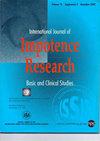Penile prosthesis implantation is safe and effective in Peyronie’s disease patients with and without erectile dysfunction
IF 2.8
3区 医学
Q2 UROLOGY & NEPHROLOGY
引用次数: 0
Abstract
Penile prosthesis (PP) is the mainstay of treatment in Peyronie’s disease (PD) with co-existent refractory erectile dysfunction (ED). This study aimed to assess the clinical outcomes of patients who underwent PP as the first-line surgical treatment in PD without ED. A total of 636 patients underwent PP for PD from 2012 to 2022, but only 168 patients who underwent PP as first-line surgical management for PD with or without ED were included in the study. The mean (SD) age of 168 patients was 56.3 years (12.4). The mean curvature of the “PD with ED” group and the “PD without ED” group were 38.2 (5.6) degrees and 42.2 (5.9) degrees. The median (IQR) follow-up was 56.0 months (34.5– 61.4). Most (86.9%) patients underwent 3-piece inflatable PP. An important finding is that 33 patients (19.6%) without ED had undergone PP. Mechanical failure requiring revision surgery was less common in the ‘without ED’ group than in the ED group (6.8% vs. 10.2%, p 0.04). Most PD patients without ED (87.9%, 29/33) and with ED (88.9%, 120/135) were “satisfied” after PP implantation at six months, as defined by a score of ≥4 on a 5-point Likert scale. If surgery is offered in PD, PP may be considered a safe and effective first-line surgical treatment regardless of the ED, given the acceptable complications and high satisfaction rates. However, this new concept warrants further research.


对于伴有或不伴有勃起功能障碍的佩罗尼病患者来说,阴茎假体植入安全有效。
阴茎假体(PP)是治疗合并难治性勃起功能障碍(ED)的佩罗尼氏病(PD)的主要方法。本研究旨在评估接受PP作为一线手术治疗的无勃起功能障碍佩罗尼氏病患者的临床疗效。从2012年到2022年,共有636名患者接受了PP治疗,但只有168名患者接受了PP作为伴有或不伴有ED的PD的一线手术治疗。168名患者的平均(标清)年龄为56.3岁(12.4岁)。伴有 ED 的 PD "组和 "不伴有 ED 的 PD "组的平均弧度分别为 38.2 (5.6) 度和 42.2 (5.9) 度。随访中位数(IQR)为 56.0 个月(34.5- 61.4)。大多数患者(86.9%)接受了三件式充气 PP。一个重要的发现是,33 名无 ED 的患者(19.6%)接受了 PP 术。与 ED 组相比,"无 ED "组中需要进行翻修手术的机械故障发生率较低(6.8% 对 10.2%,P 0.04)。大多数无 ED 的 PD 患者(87.9%,29/33)和有 ED 的 PD 患者(88.9%,120/135)在 PP 植入 6 个月后表示 "满意",即在 5 点李克特量表中得分≥4 分。考虑到可接受的并发症和较高的满意度,如果在腹腔镜下进行手术治疗,那么无论ED如何,PP都可被视为一种安全有效的一线手术治疗方法。不过,这一新概念还需要进一步研究。
本文章由计算机程序翻译,如有差异,请以英文原文为准。
求助全文
约1分钟内获得全文
求助全文
来源期刊

International Journal of Impotence Research
医学-泌尿学与肾脏学
CiteScore
4.90
自引率
19.20%
发文量
140
审稿时长
>12 weeks
期刊介绍:
International Journal of Impotence Research: The Journal of Sexual Medicine addresses sexual medicine for both genders as an interdisciplinary field. This includes basic science researchers, urologists, endocrinologists, cardiologists, family practitioners, gynecologists, internists, neurologists, psychiatrists, psychologists, radiologists and other health care clinicians.
 求助内容:
求助内容: 应助结果提醒方式:
应助结果提醒方式:


